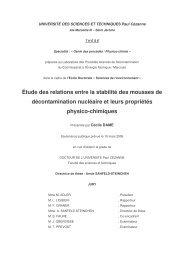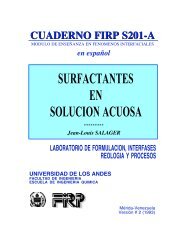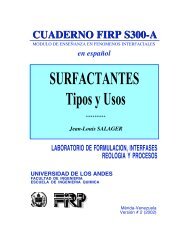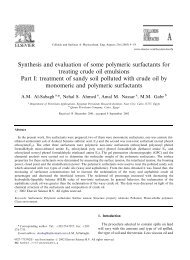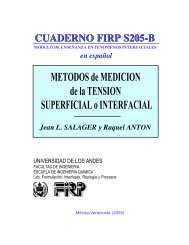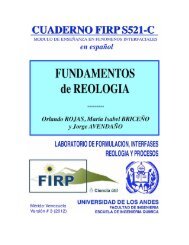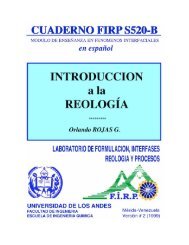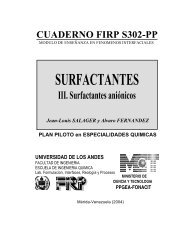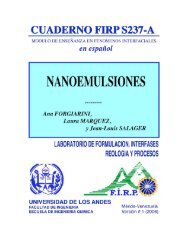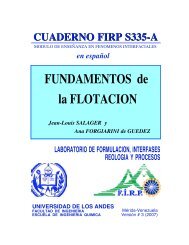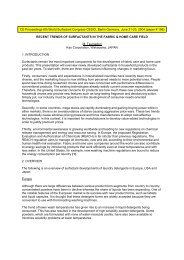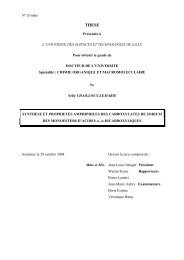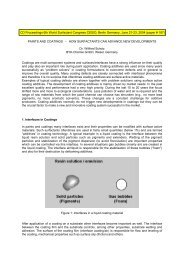Solubilization-emulsification mechanisms of detergency
Solubilization-emulsification mechanisms of detergency
Solubilization-emulsification mechanisms of detergency
Create successful ePaper yourself
Turn your PDF publications into a flip-book with our unique Google optimized e-Paper software.
C.A. Miller and K.H. Raney/Colloids Surfaces A: Physicochem. Eng. Aspects 74 (1993) 169-215 177<br />
non-ionic surfactants for which temperature is<br />
usually the variable <strong>of</strong> greatest interest. For<br />
ionic surfactants it is more common to speak <strong>of</strong><br />
"optimal" conditions, e.g. optimal salinity [37].<br />
Whatever one calls it, several criteria have been<br />
used to define the condition for balance in terms<br />
<strong>of</strong> readily measured experimental quantities.<br />
The most common criterion is equal volumetric<br />
solubilization in the microemulsion <strong>of</strong> the oil<br />
and water phases. The differences between the<br />
"optimal" conditions given by this and other<br />
criteria are small for practical purposes and will<br />
be ignored here.<br />
The effects <strong>of</strong> temperature and inorganic salts<br />
on making the surfactant more or less<br />
hydrophilic are basically the same as those<br />
described in the preceding section, and so are<br />
the effects <strong>of</strong> adding alcohols or additional<br />
surfactants, except that one additional factor<br />
must be considered - the relative solubilities <strong>of</strong><br />
the surfactants and additives in the oil phase. It<br />
is the composition <strong>of</strong> the surfactant films<br />
separating oil and water domains that<br />
determines the microstructure <strong>of</strong> the<br />
microemulsion. In a mixture <strong>of</strong> two non-ionic<br />
surfactants the more lipophilic surfactant has a<br />
higher solubility in the oil phase and the<br />
surfactant films are thus more hydrophilic than<br />
the overall surfactant mixture. The magnitude <strong>of</strong><br />
this effect for a given pair <strong>of</strong> surfactants<br />
depends on both the overall surfactant<br />
concentration and the water-to-oil ratio.<br />
Kunieda, Shinoda and co-workers have<br />
developed equations for predicting the<br />
dependence <strong>of</strong> the PIT on system composition<br />
for mixtures <strong>of</strong> two non-ionic surfactants [38]<br />
and for mixtures <strong>of</strong> an anionic and a non-ionic<br />
surfactant [39]. For instance, in the latter case<br />
the following relationship must be satisfied at<br />
the PIT<br />
W n = S sn + S onR ow [(1 - S sn)/(1 - S on)] (X -1) (2)<br />
where W n is the mass fraction <strong>of</strong> non-ionic<br />
surfactant in the overall mixture, S sn is the mass<br />
fraction <strong>of</strong> non-ionic surfactant in the surfactant<br />
films, S on is the mass fraction <strong>of</strong> non-ionic<br />
surfactant in the excess hydrocarbon phase, R ow<br />
is the mass fraction <strong>of</strong> oil in the oil-water<br />
mixture, and X is the total surfactant mass<br />
fraction in the system. The solubility <strong>of</strong> the<br />
anionic surfactant in the excess oil has been<br />
neglected.<br />
It is clear from this equation that a plot <strong>of</strong> Wn<br />
as a function <strong>of</strong> (X -1 - 1) at constant Row and<br />
temperature should yield a straight line from<br />
which values <strong>of</strong> Ssn and Son can be extracted.<br />
Figure 7 shows such plots for mixtures <strong>of</strong> C 12E 3<br />
and Neodol 23-3S at various temperatures along<br />
with the corresponding values <strong>of</strong> Ssn and Son.<br />
The oil phase is n-hexadecane and the aqueous<br />
phase is water containing 1 wt.% NaCl. As<br />
might be expected, nonionic surfactant<br />
solubility in the oil phase S on increases with<br />
increasing temperature. In contrast, the fraction<br />
S sn <strong>of</strong> nonionic surfactant in the films decreases.<br />
Since increasing temperature makes the nonionic<br />
surfactant less hydrophilic, it is reasonable<br />
that less <strong>of</strong> it would be required to achieve the<br />
Fig. 7. PIT results for the C12E3-Neodol 23-3S-1<br />
wt.% NaCl brine-n-hexadecane system [24]; X is the<br />
total surfactant mass fraction in the system.<br />
Reprinted with permission from Dr. Dietrich<br />
Steinkopff Verlag.



